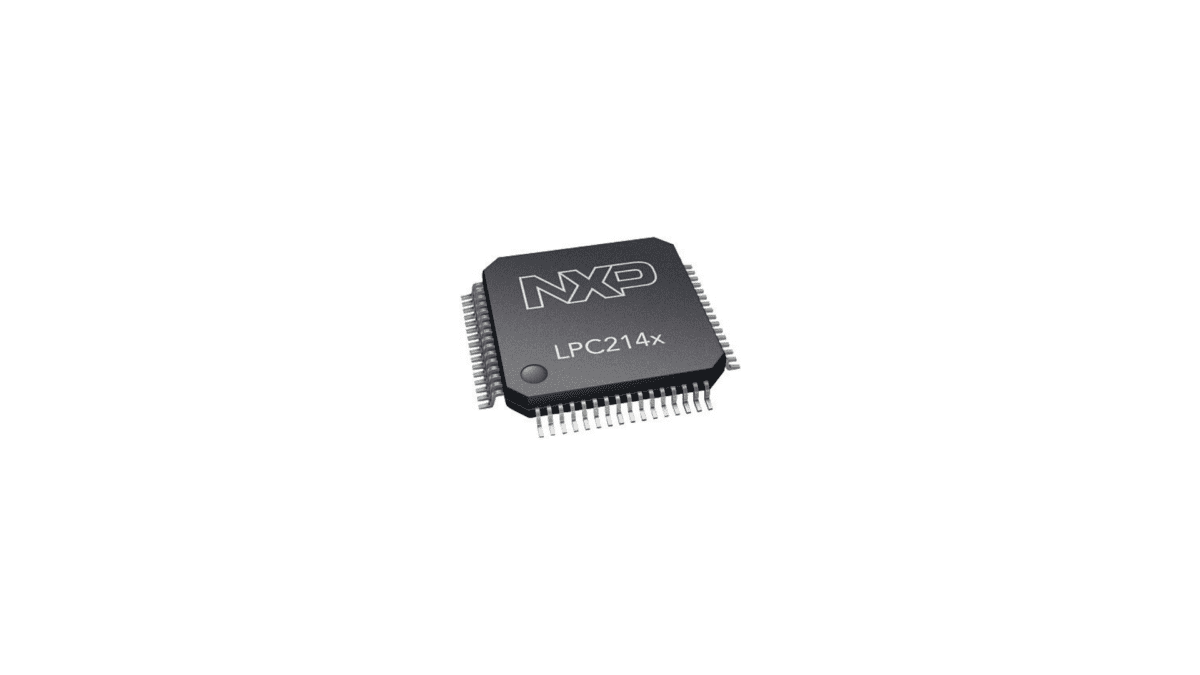you certainly don’t know a tool called this microcontroller.
It can be said that this microcontroller is a chip that has an important role in programming in various electronic devices.
In this article, we will discuss the understanding of microcontrollers, working principles, structures, block diagrams, advantages, disadvantages, types, functions and differences. For that, see the discussion below.
What is Microcontroller
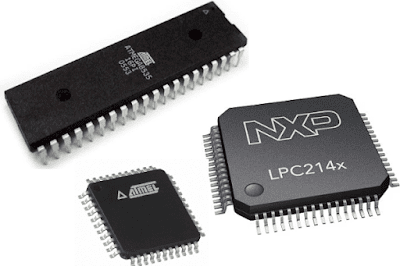
Microcontroller is a small computer that is packaged in the form of an IC (Integrated Circuit) chip and is designed to perform certain tasks or operations.
Generally a microcontroller IC consists of one or more processor cores (CPU), memory (RAM and ROM) and programmable input and output devices.
In its application, the micro controller which in English is called the microcontroller is used in products or devices that are controlled automatically.
Examples include car engine control systems, remote controls, medical devices and devices that use other embedded systems.
The use of this microcontroller is increasingly popular because of its ability to reduce the size and cost of a product or design when compared to designs built using microprocessors with memory and separate input and output devices.
Microcontroller Working Principle
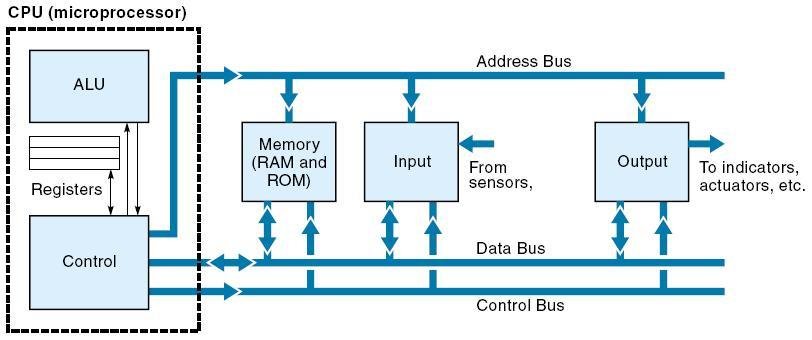
After discussing the meaning of the microcontroller, then the next thing is that there is a working principle.
Microcontroller is used as a controller or controller of a system. In carrying out these functions, these components require the support of other parts such as those incorporated in the microcontroller IC.
Depending on the function and purpose, any incoming data or commands are then processed in the CPU section. The processing is assisted by other parts such as timers, RAM, CDA or ADC.
Difference Between Microcontroller and Microprocessor
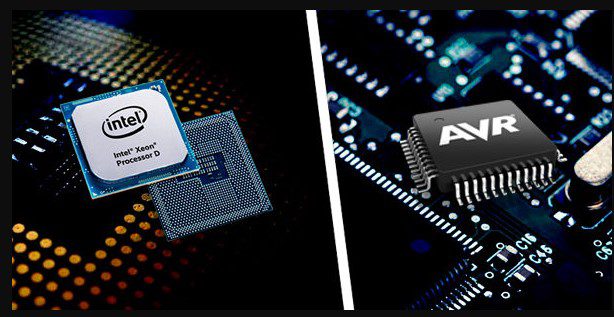
Microcontroller is an IC component that performs the controlling function. It contains other components.
Examples such as ADC, RAM, CDA and many more. The data processing center of the microcontroller is called the CPU.
While the microprocessor is the CPU (Control Processing Unit) itself, so the history of the microprocessor can be referred to as part of the microcontroller.
This microprocessor has components such as ALU (Aritmati Logic Unit), registers, control unit and interconnected CPU.
To better understand how it works, you can see the image of the microprocessor block diagram above.
Microcontroller Block Diagram and Structure
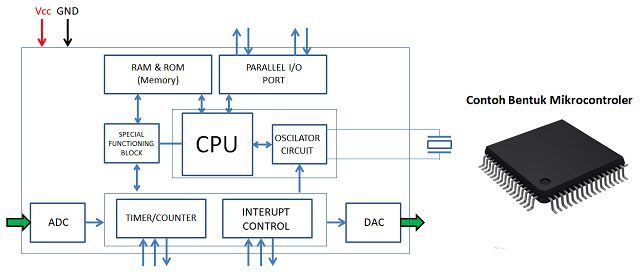
The following is the structure and block diagram of the microcontroller along with an explanation of its main parts.
1. CPU
CPU is the brain of the microcontroller. The CPU is responsible for fetching instructions (fetch), decoding them (decode), then finally executing (execute).
The CPU connects every part of the microcontroller into one system. Its main function is to retrieve and decode instructions.
Instructions taken from program memory must be decoded or decoded by the CPU.
2. Serial Port (Serial Port)
The serial port provides various serial interfaces between the microcontroller and other peripherals such as the parallel port.
3. Memory (Storage)
This memory is in charge of storing data. The data is data that has been processed (output) or data that has not been processed (input).
This storage is in the form of RAM and ROM. ROM is used to store data for a long period of time.
While RAM is used to store data temporarily while the program is running until it is finally moved to ROM.
As for some parts of RAM, including:
- Contact point
- Packaging chips
- CSP (Chip Scale Package)
- DIP (Dual In-Line Package)
- PCB (Printed Circuit Board)
- TSOP (Thin Small Outline Package)
- DRAM (Dynamic Random Access Memory)
4. Parallel Input/Output Port
Parallel input/output ports are used to drive or connect various devices such as LEDs , LCDs , printers, memory and other input/output devices to the microcontroller.
5. ADC (Analog to Digital Converter)
ADC converter (Analog to Digital Converter) is used to convert analog signals to digital form.
The input signal in this converter must be in analog form (eg output from a sensor) while the output is in digital form.
Digital outputs can be used for various digital applications such as digital displays in measuring devices.
6. DAC (Digital to Analog Converter)
DAC (Digital to Analog Converter) performs the ADC (Analog to Digital Converter) conversion reversal operation.
The DAC converts the digital signal into an analog format. This DAC is usually used to control analog devices such as DC motors and so on.
7. Interrupt Control
Interrupt Control is in charge of controlling delays in microcontroller programming.
The interrupt control section can be operated internally or externally.
8. Special Functioning Block
The special functioning block is an additional part that is made to have a special function.
Usually this block is found in the microcontroller architecture in robotics machines. Not all devices use this section.
9. Timer and Counter
This timer/counter is used for measuring time and counting tools. The existence of this component is very important.
Because time information is often used to make system settings more accurate and effective.
Advantages and Disadvantages of Microcontroller
After the previous admin explained about the definition of a microcontroller, working principles, differences, structure and block diagrams, then there are advantages and disadvantages that you can know.
The main advantages of the microcontroller:
- The time required to perform the operation is low.
- Easily connect additional RAM, ROM and I/O ports.
- Most pins can be programmed by the user to perform various functions.
- Can reduce the cost and size of the system, due to complete integration in a microcontroller.
- The microcontroller acts as a microcomputer without the need for any additional digital components.
- The use of the microcontroller is simple and easy for troubleshooting and system maintenance.
Disadvantages of the microcontroller:
- Most are only used in micro-equipment.
- Cannot connect with high power devices directly.
- Microcontrollers have a more complex architecture than microprocessors.
- Only execute a limited number of times at the same time.
Microcontroller Types
Microcontrollers are divided into several types according to their function. The types of microcontrollers include:
1. AVR Microcontroller
AVR microcontroller is a type of 8 bit RISC microcontroller. This type is included in the RISC, so all the instruction code will be packaged in a clock cycle.
AVR is the most common type of microcontroller used in electronics and instrumentation.
This microcontroller is a type of microcontroller architecture that is the mainstay of Atmel. This architecture is specially designed by offering various advantages and improvements from the existing microcontroller architecture.
Atmel has produced various series of AVR microcontrollers and has been marketed worldwide as a microcontroller with low cost and high performance characteristics.
the AVR microcontroller has been widely used, because it offers a very complete range of features, is easy to obtain and has an affordable price.
2. MSC 51 . Microcontroller
The MSC 51 type microcontroller is included in the CISC family where almost all instructions will be executed at 12 clock cycles.
This type of microcontroller uses the Harvard architecture and was originally designed specifically for single-chip microcontroller applications.
However, the expansion mode allows an external 64 kb ROM and an external 64 kb RAM to be addressed by means of a separate chip selection path for program access and data memory.
One of the advantages of the 8051 microcontroller is the inclusion of a boolean processing engine which allows bit-level boolean logic operations to be performed efficiently in internal registers and RAM.
Therefore, MCS51 is often used in early PLC designs. MCS51 is an atmel production which is divided into 2 versions, namely a 20 foot version and a 40 foot version.
Almost all types of MCS51 microcontrollers are equipped with PEROM flash (Programmable Eraseable Read Only Memory) as program memory media and the arrangement of these IC legs reaches each version.
3. PIC Microcontroller
PIC stands for Programmable Interface Controller. But along with its development, it underwent a change into a Programmable Intelligent Computer.
PIC is a type of RISC type microcontroller where this microcontroller uses the Harvard architecture that has been made by microchip technology.
It was first developed by the general instrument microelectronic division which has the name PIC1640.
PIC microcontroller is a single circuit that has a small size and contains memory processing units, clocks and inputs or outputs in a single unit.
This PIC can be purchased blank which is then added with a certain control program.
This PIC is very popular among developers and hobbyists, because the cost is fairly cheap.
Wide availability and use, large application databases and programming via serial port connections that exist on a computer.
4. ARM . Microcontroller
The microcontroller is a processor with a 32-bit RISC family of instruction set architecture that has been developed by ARM holdings.
ARM (Advanced RISC Machine) was previously known as the Acorn RISC Machine.
Initially, the ARM Processor was developed by PCs or personal computers by Acorn Computers.
However, with the dominance of the Intel x86 Microsoft process on compatible IBM PCs, Acorn Computer has gone out of business.
Microcontroller Function
As for some of the main functions of the microcontroller, including:
- As a counter
- As a flip-flop
- As an oscillation generator
- As a decoder and encoder
- As a timer or timer
- As ADC (Analog to Digital Converter)
Thus an explanation of the definition of a microcontroller, working principle, structure, block diagram, advantages, disadvantages, types, functions and differences. Hopefully it can be useful for all of us. Bye bye, thank you

